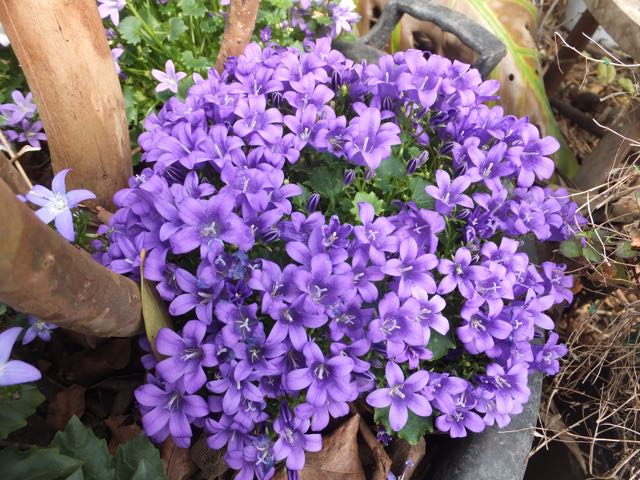
As often found in an alpine house as a greenhouse many Bellflowers, Campanulas, are rock garden and border plants. However some low growing and prostrate species are delightful under cover for filling in around the base of taller plants with their verdant foliage and masses of cool blue flowers.
Campanula is an interesting, floriferous and very large genus of mostly perennial herbaceous plants the most well known being the hardy Canterbury Bells. From this and similar cup shaped blooms the genus gets it’s name, the form of the bloom allowing bees access for more effective pollen distribution. Because of this bee association most Campanulas are blue, the colour bees see best, and have little or no scent as bees are not attracted by perfume.
The Bellflowers have long been in cultivation, most come from central and Eastern Europe and Mediterranean regions though others are native worldwide, many are found in mountains, particularly the Alps. It these latter that have given us our most useful subjects for a cool greenhouse.
From the Italian side of the Alps comes C. isophylla, the Ligurian Harebell, with trailing stems this produces violet blue cup shaped blooms in profusion all summer. There are several varieties available including a white form Alba and a China blue Mayi. Very similar and more vigorous are C. portenschlagiana / poscharskyana varieties. (At the other end of the spectrum is C. zoysii which has been described as ‘a very choice Alpine” which I’m afreaid translates as small and miffy.)
Fortunately most Campanulas are fairly easy to grow from seed and flower in their first years though named varieties need be propagated from cuttings or division in the spring. Most species thrive in any well drained compost and require little attention as these are not pest or disease prone (other than the usual suspects such as slugs and snails). Light feeding with their watering during the growing season will help the flowering continue. In autumn watering needs reducing and the plants keeping on the dry side through winter or they may be lost. Especially C. isophylla which needs frost protection as well.
A curious species you might consider is C. rapunculus. This native of European hedgerows is a pretty wildflower, however given rich compost and a protected environment this grows into one of the most interesting of salads. Rampions were once incredibly popular but are now forgotten. The young leaves are eaten as green salad, and are sweeter and more succulent when grown under cover than in the wild. And then later as the plants mature the odd little radish like roots can be eaten which have a nutty sort of flavour. If you find you don’t like either don’t worry as these go on to produce pretty blue harebell like flowers.


